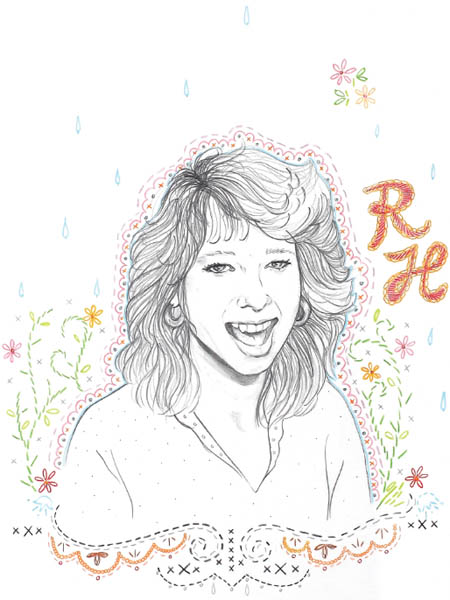Jenny Hart is a Los Angeles–based artist and businesswoman. She owns Sublime Stitching, an independent DIY company that creates alternative embroidery patterns, kits, textiles, and courses. Thousands of people from around the world have been inspired to start embroidering thanks to Jenny!
When it comes to her personal art practice (which she considers completely separate), she focuses on drawing and embroidery. She has drawn seriously from a young age, when her mother would enroll her in any class she could find. When Jenny took a yearlong break from the University of Kansas at Lawrence, she lived and worked in Paris, going to open studios so that she could draw live models. As far as embroidery goes, she is completely self-taught. Her alternative education certainly paid off, because her beautiful work is now in the permanent collection of the Smithsonian American Art Museum, among others.
JC—Why are you an artist?
JH—It’s all I ever wanted to be. My mom sent me to my first art class when I was five, and I just knew it was what I wanted to be when I grew up. My heroes weren’t athletes or rock stars—they were artists. I guess I’m an artist because I hope to be inspiring, because I was inspired. I thought that was the greatest thing you could be. I still do!
JC—When did you truly feel like an artist?
JH—I was seventeen. I loaned a set of collages I’d made to a high school friend. Her aunt, without my knowing, took them to a gallery about thirty minutes away. The gallery contacted me and said they wanted to mount a solo show of my work. People began buying and collecting my work. That felt real to me. Even though I’d wanted to be an artist since I was little, until I had feedback it felt like I was just pretending.
JC—You draw and embroider beautifully. Do you have a favorite?
JH—Drawing. Once I started stitching, embroidering felt like drawing in slow motion.
JC—Which artist’s work are you most jealous of, and why?
JH—I find the work of Yumiko Arimoto depressingly awesome. It’s the work that makes you want to give up because it’s so mind-blowing. But, I’m not a very envious person. When I see amazing, truly original work, it makes me feel inspired to revisit my own, and try harder.
JC—Where does your inspiration come from?
JH—It comes very much through music, film, books, a face I see on the street. . . . It’s very difficult to describe how that turns into my artwork, but it does. I see in pictures. I can see images in my mind as clearly as if they’re in front of my face.
JC—When those images pop into your mind, do you sketch them?
JH—I keep a sketchbook of ideas and usually put them down in a way that will remind me what I was thinking. When I do this, and go back to these little reference entries, I can remember exactly the images I had in my head. Otherwise, they’re too often forgotten!
JC—How would you describe a creative block?
JH—I call it creative fatigue. I won’t feel like working, or won’t feel like working on something that has a deadline. I reach the point with nearly every work where I think it’s going wrong, so I just walk away—but even just a fifteen-minute break can do wonders!
JC—Do you think people should toss their work if they’re not happy with it?
JH—I truly believe that you should never throw your works away. Even if you’re not going to show it to anyone or finish it, your abandoned works will look very different to you after time has passed. When I come across works from a few years ago, they look fresh to me, and I can’t understand why I gave up on them. I think it’s a very important practice, and can really boost your perspective. You’ll see how you’ve improved, and you’ll also see, more often, that it was much better than you thought.
JC—Do you ever equate your self-worth with your artistic successes?
JH—Wow. I’ve never been asked what I equate my self-worth with. I still feel like I’ve made the greatest personal achievement when I’ve made a beautiful or accurate drawing. Which is pretty silly, because a beautiful drawing never saved anyone’s life. But if I do a bad drawing, or I really struggle with something I want to create, the thoughts of “who am I kidding, I’m just a hack” arrive instantly.
JC—Ah, your inner critic! So, are you able to quiet that pesky voice?
JH—My inner critic doesn’t tell me to give up, but I rarely look at my own work and feel satisfied. I always see what’s wrong with it, where I feel I fell short. When someone is complimenting me, it can be hard for me to say thank you—I want to say “No! It’s not really very good, I wanted it to be much better!” I’ve had to make that voice shut up on more than one occasion.
JC—What was the most helpful bit of constructive criticism you’ve ever received?
JH—A really good friend of mine was looking at my work and said, kind of amused, “Boy, you really don’t like negative space.” Meaning: I tend to fill up every area of the image, sometimes when it’s really not necessary. He said it made it look overly busy at times. I had never realized that before, and he felt my work would benefit from visually breathing a bit more. It’s stuck with me, and it’s been really helpful when I find myself struggling.

When I see amazing, truly original work, it makes me feel inspired to revisit my own, and try harder.